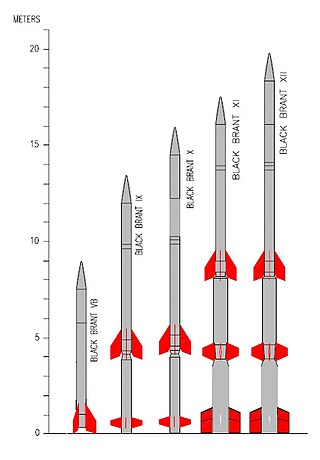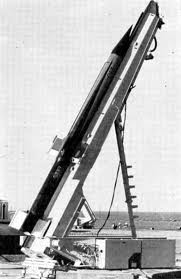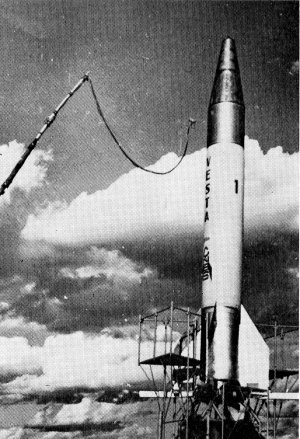Related Research Articles

A rocket is a vehicle that uses jet propulsion to accelerate without using the surrounding air. A rocket engine produces thrust by reaction to exhaust expelled at high speed. Rocket engines work entirely from propellant carried within the vehicle; therefore a rocket can fly in the vacuum of space. Rockets work more efficiently in a vacuum and incur a loss of thrust due to the opposing pressure of the atmosphere.

The Diamant rocket was the first exclusively French expendable launch system and at the same time the first satellite launcher not built by either the United States or USSR. As such, it has been referred to as being a key predecessor for all subsequent European launcher projects.

Vostok was a family of rockets derived from the Soviet R-7 Semyorka ICBM and was designed for the human spaceflight programme. This family of rockets launched the first artificial satellite and the first crewed spacecraft (Vostok) in human history. It was a subset of the R-7 family of rockets.

The Black Brant is a family of Canadian-designed sounding rockets originally built by Bristol Aerospace, since absorbed by Magellan Aerospace in Winnipeg, Manitoba. Over 800 Black Brants of various versions have been launched since they were first produced in 1961, and the type remains one of the most popular sounding rockets. They have been repeatedly used by the Canadian Space Agency and NASA.

Titan IV was a family of heavy-lift space launch vehicles developed by Martin Marietta and operated by the United States Air Force from 1989 to 2005. Launches were conducted from Cape Canaveral Air Force Station, Florida and Vandenberg Air Force Base, California.

Le Redoutable was the lead boat of her class of ballistic missile submarines in the French Marine Nationale.

The VE 210 Rubis was a French two-stage rocket.

Centaure was a two-stage French sounding rocket consisting of a Venus first stage and a Belier second stage. It belongs to a family of solid-propellant rockets consisting of the Belier, Centaure, Dragon, Dauphin, and Eridan.
Nike Hydac is the designation of an American sounding rocket with two stages, based upon the Nike Ajax booster. The Nike Hydac was launched 87 times from many missile sites. Such sites were White Sands Missile Range, Poker Flat Research Range, Kwajalein Missile Range, Cassino Site - Rio Grande Airport, Brazil, and from North Truro Air Force Station in Massachusetts during Operation Have Horn in 1969.

The Minotaur is a family of United States solid fuel launch vehicles derived from converted Minuteman and Peacekeeper intercontinental ballistic missiles (ICBM). They are built by Northrop Grumman via contract with the Air Force Space and Missile Systems Center's Space Development and Test Directorate (SMC/SD) as part of the Air Force's Rocket Systems Launch Program which converts retired Intercontinental Ballistic Missiles into space and test launch systems for U.S. government agencies.

This comparison of orbital launch systems lists the attributes of all individual rocket configurations designed to reach orbit. A first list contains rockets that are operational or in development as of 2023; a second list includes all upcoming rockets and a third list includes all retired rockets For the simple list of all conventional launcher families, see: Comparison of orbital launchers families. For the list of predominantly solid-fueled orbital launch systems, see: Comparison of solid-fueled orbital launch systems.

Space Launch Complex 2 (SLC-2) is an active rocket launch site at Vandenberg Space Force Base, in California, USA. It consists of two launch pads. The East pad was used for Delta, Thor-Agena and Thorad launches between 1966 and 1972 and has been demolished. The West pad was used for Delta, Thor-Agena and Delta II launches from 1966 until 2018, when the Delta II performed its last flight.
The Universal Rocket or UR family of missiles and carrier rockets is a Russian, previously Soviet rocket family. Intended to allow the same technology to be used in all Soviet rockets, the UR is produced by the Khrunichev State Research and Production Space Center. Several variants were originally planned, of which only three flew, and only two of which entered service. In addition, the cancelled UR-500 ICBM formed the basis for the Proton carrier rocket.

The Atlas H was an American expendable launch system derived from the SM-65 Atlas missile. It was a member of the Atlas family of rockets, and was used to launch five clusters of NOSS satellites for the US National Reconnaissance Office. Two flights also carried LiPS satellites, as secondary payloads for the United States Naval Research Laboratory.

The 53T6 is a Russian anti-ballistic missile. Designed in 1978 and in service since 1995, it is a component of the A-135 anti-ballistic missile system.
White Sands Launch Complex 36 (LC-36) is a site at White Sands Missile Range used for launches of the Black Brant IX and Black Brant 9CM1. It was also used from May 1964 and January 1966 to launch the Little Joe 2 rocket for the Apollo Program.
The Interarmy Special Vehicles Test Centre (CIEES) (French: Centre Interarmées d'Essais d'Engins Spéciaux) was France's first space launch and ballistic missile testing facility. Outside France, the facility is often referred to by the name of the nearest town, Hammaguir (also called Hammaguira). It was established on 24 April 1947, by ministerial decree as the Special Weapons Test Center (CEES, Centre d'essais d'engins spéciaux) for use by the French Army. In 1948, it was turned over to the French Air Force, who renamed it CIEES. Its remote location in the middle of the Saharan Desert and its relative closeness to the Equator (compared with Metropolitan France) made it an attractive launch site for missiles and orbital rockets.

VE 121 Émeraude was a large French sounding rocket of the 1960s.

The Vesta sounding rocket, conceived in 1962 by the Laboratoire de recherches balistiques et aérodynamiques (LRBA), a specialized French Army research facility focused on liquid-propelled rocket development. The initial letter "V" in its name is derived from the city of Vernon.
CERESIle du Levant was a French suborbital rocket launch site, located at Ile du Levant, and active between 1956 and 1968. CERES played a pivotal role in testing a wide array of tactical missiles used in France, as well as conducting tests for sounding rockets on behalf of CNES and ESRO. Additionally, the center was involved in experiments with ONERA and SEREB experimental vehicles, solidifying its significance in the realm of missile research and testing.
References
- 1 2 "Centre d'essais des Landes (CEL) de Biscarosse : soixante ans de savoir-faire balistique". imagesdefense.gouv.fr (in French). Retrieved 2023-09-02.
- ↑ Capdevila, Didier. "Le CEL Centre d'Essai des Landes". Capcom Espace. Retrieved 2023-09-02.
- 1 2 "Biscarosse". www.astronautix.com. Retrieved 2023-09-03.
- 1 2 Serra, Jean-Jacques (2005). "Levant island and Biscarosse". Rockets in Europe. Archived from the original on 2005-02-04. Retrieved 2023-09-02.
- ↑ "Biscarosse BLB". www.astronautix.com. Retrieved 2023-09-03.
- ↑ "Biscarosse CE". www.astronautix.com. Retrieved 2023-09-03.
- ↑ "Biscarosse BESA". www.astronautix.com. Retrieved 2023-09-03.
- ↑ "Biscarosse SUD". www.astronautix.com. Retrieved 2023-09-03.
- ↑ "Biscarosse BE". www.astronautix.com. Retrieved 2023-09-03.
- ↑ "Biscarosse BP". www.astronautix.com. Retrieved 2023-09-03.
- ↑ "Biscarosse BS". www.astronautix.com. Retrieved 2023-09-03.